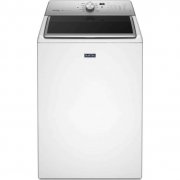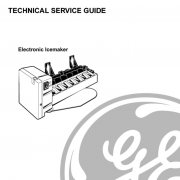Gas Dryer Repair
Dryer Won’t Heat
Gas dryers are fairly simple machines . With a basic understanding of how the parts of a gas dryer work and a little DIY gas dryer repair coaching from yours truly, you will be able to repair many gas dryer problems yourself. All tests should be performed with the dryer unplugged and all wires connected to the part being tested unplugged.
(Note: Label all terminals and connecting wires before disconnecting them for proper reinstallation.)
Igniter | Thermal Fuse | Hi-Limit Thermostat | Thermal Cut-Off | Cycling Thermostat | Thermostat Heater | Timer | Temperature Switch | Valve Solenoids (Coils) | Flame Switch | Burner | Thermistor | Moisture Sensor | Air Flow | Gas Supply | Dryer Won’t Start | Dryer Noises | Electric Dryer Repair
Gas Dryer Repair – Possible causes
“Dryer won’t heat” or “Dryer not hot enough”
Gas Dryer Igniter:
The dryer igniter is responsible for igniting gas released from the burner valve. It receives electricity from the timer through a thermal fuse. For the DIY dryer repair person, if the dryer igniter is heating up it is not the cause of a no heat or low heat problem. Also, if the dryer’s igniter is not heating up, either the igniter is broken, or it may not be receiving electricity from the timer or control board through the dryer’s thermal fuse to do its work. The dryer igniter rarely fails, but if replacement is need for your dryer repair, be careful not to break the delicate new igniter or touch the part of the igniter that heats up. Oils from your skin can shorten the new igniter’s life expectancy. And you will be putting on your dryer repair hat again soon.
Dryer Symptoms: The dryer won’t heat.
Test: How-To Test A Dryer Igniter Video.
Unplug the igniter and check for resistance through the dryer igniter contacts. A small amount of resistance should be measured in the dryer igniter to create the heat required for dryer burner ignition. If the igniter tests okay and is not heating, check the dryer’s thermal fuse, flame switch, hi-limit thermostat, motor contacts, and timer, in that order.
Gas Dryer Thermal Fuse:
 The dryer’s thermal fuse is a non-resettable safety fuse that is designed to break electrical contact to the dryer’s burner if the dryer becomes too hot. This fuse will often burn out due to clogged dryer ducting or a defective cycling thermostat. The thermal fuse is the most common cause when a dryer has no heat.
The dryer’s thermal fuse is a non-resettable safety fuse that is designed to break electrical contact to the dryer’s burner if the dryer becomes too hot. This fuse will often burn out due to clogged dryer ducting or a defective cycling thermostat. The thermal fuse is the most common cause when a dryer has no heat.
Dryer Symptoms: On a gas dryer the dryer will not start. However, in electric dryers, the dryer won’t heat.
Test: How-To Test A Dryer Fuse Videos.
Disconnect all connecting wires and check for continuity across the two wire contacts. There should be no resistance measured (a closed circuit, allowing electricity to flow).
Gas Dryer Valve Solenoids(Coils):
Gas dryers use a set of solenoids (also called safety coils) to open the dryer’s gas valve automatically after the flame switch has opened, indicating that the igniter is hot enough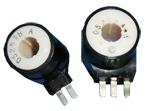 to ignite released gas. As safety coils are going bad, they will work properly for a short period. Then after a half an hour or so of cycling on and off to maintain the drum’s temperature, they will break down and cease to open the valve, resulting in cool, wet clothing at the end of the cycle. Solenoids commonly need to be replaced in a gas dryer.
to ignite released gas. As safety coils are going bad, they will work properly for a short period. Then after a half an hour or so of cycling on and off to maintain the drum’s temperature, they will break down and cease to open the valve, resulting in cool, wet clothing at the end of the cycle. Solenoids commonly need to be replaced in a gas dryer.
Dryer Symptoms: Dryer won’t heat at all or dryer will heat for a very short time then the dryer won’t heat until it has been turned off for a time to allow the coils to cool down.
Test: If the igniter is getting hot and cycling off after the flame switch opens, but no gas is released, the coils are likely the cause.
Gas Dryer Burner Valve:
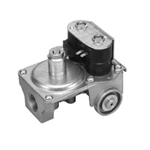 Gas dryers use a burner to generate the heat required to dry your clothes. These valves are extremely reliable and almost never need replacement. The valve is opened automatically by a set of solenoid coils. In some cases, allowing a propane tank to go dry can cause the valve to fail. However, all other possible causes should be checked before the dryer’s valve is replaced. The safety coils are the most common cause of a valve, not opening. Note: A valve you intend to use again should not be opened for any reason because this can cause dangerous gas leaks.
Gas dryers use a burner to generate the heat required to dry your clothes. These valves are extremely reliable and almost never need replacement. The valve is opened automatically by a set of solenoid coils. In some cases, allowing a propane tank to go dry can cause the valve to fail. However, all other possible causes should be checked before the dryer’s valve is replaced. The safety coils are the most common cause of a valve, not opening. Note: A valve you intend to use again should not be opened for any reason because this can cause dangerous gas leaks.
Dryer Symptoms: Dryer won’t heat, or dryer is not hot enough.
Gas Dryer Flame Switch:
 The flame switch (also called the window sensor) is used in gas dryers to guarantee that the igniter is hot enough to ignite gas once it is released from the valve. When the flame switch is cool, it is closed, allowing electricity to energize the dryer’s igniter. But after it heats up, because of its proximity to the igniter, it opens routing power to the valve solenoids to open the valve and release gas. The flame switch rarely needs replacement.
The flame switch (also called the window sensor) is used in gas dryers to guarantee that the igniter is hot enough to ignite gas once it is released from the valve. When the flame switch is cool, it is closed, allowing electricity to energize the dryer’s igniter. But after it heats up, because of its proximity to the igniter, it opens routing power to the valve solenoids to open the valve and release gas. The flame switch rarely needs replacement.
Test: To test the flame switch, support the switch’s terminals with a pair of needle nose pliers while you disconnect the two connecting wires. Check for continuity across the switches terminals. There should be no resistance measured when the dryer is cool (a closed circuit, allowing electricity to flow.) If the igniter heats up but never clicks off, replace the dryer’s flame switch.
Dryer Symptoms: Dryer won’t heat.
Gas Dyer Hi-Limit Thermostat:
The hi-limit thermostat is a safety switch that will break  electrical contact to the dryer’s burner or heater if it senses that the dryer has become too hot. The hi-limit thermostat will cycle the dryer’s burner or heater off if the ducting has become clogged blocking proper airflow.
electrical contact to the dryer’s burner or heater if it senses that the dryer has become too hot. The hi-limit thermostat will cycle the dryer’s burner or heater off if the ducting has become clogged blocking proper airflow.
Dryer Symptoms: Usually a very short heating period with a low drum temperature or dryer won’t heat at all. The hi-limit thermostat is a relatively reliable dryer component and is rarely the cause of dryer not heating problems.
Test: Disconnect all connecting wires and check for continuity across the hi-limit thermostat or sensor set.
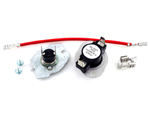 The dryer’s thermal cut-off is similar to the thermal fuse and the high limit thermostat. It will break electrical contact to the dryer’s burner or heating element if it senses that the dryer is reaching an unsafe temperature. The thermal cut-off is a set of two thermostats, one of which will not reset once cool. The thermal cut-off needs to be replaced as a set. If this set of dryer parts fails, you will need to check your dryer and home ducting for clogging. And check to make sure that the dryer’s cycling thermostat is operating correctly. This type of safety thermostat does not just fail for no reason. If the non-resettable fuse has blown out, you need to check and clean your home ducting!
The dryer’s thermal cut-off is similar to the thermal fuse and the high limit thermostat. It will break electrical contact to the dryer’s burner or heating element if it senses that the dryer is reaching an unsafe temperature. The thermal cut-off is a set of two thermostats, one of which will not reset once cool. The thermal cut-off needs to be replaced as a set. If this set of dryer parts fails, you will need to check your dryer and home ducting for clogging. And check to make sure that the dryer’s cycling thermostat is operating correctly. This type of safety thermostat does not just fail for no reason. If the non-resettable fuse has blown out, you need to check and clean your home ducting!
Dryer Symptoms: Dryer won’t heat.
Test: Disconnect all connecting wires and check for continuity across the terminals. The thermal cut-off should be closed (allowing current to flow) at room temperature.
Gas Dryer Cycling Thermostat:
 The cycling thermostat is responsible for cycling the dryer’s heat source on and off to keep a target temperature. The dryer’s cycling thermostat is a very reliable bi-metal thermostat that rarely fails. This thermostat is usually closed, allowing electricity to flow freely. When the dryer heats up, it will open, breaking electrical contact to the dryer’s heat source and allowing the drum temperature to drop slightly, causing the thermostat to close again and reenergizing the dryer’s heat source.
The cycling thermostat is responsible for cycling the dryer’s heat source on and off to keep a target temperature. The dryer’s cycling thermostat is a very reliable bi-metal thermostat that rarely fails. This thermostat is usually closed, allowing electricity to flow freely. When the dryer heats up, it will open, breaking electrical contact to the dryer’s heat source and allowing the drum temperature to drop slightly, causing the thermostat to close again and reenergizing the dryer’s heat source.
The thermostat’s operating temperature range is identified on the part with an “L” followed by the temperature. For example, L130 would open (cycling the dryer’s heat off) at 130ºF. A dash followed by another number, for instance, L155-10, would mean that the dryer thermostat would close after having cooled 10ºF. Faulty cycling thermostat symptoms could take the form of very high dryer temperatures, blown out thermal fuses, or no heat. The cycling thermostat works with a thermostat heater to achieve lower dryer temperatures, such as low and medium heat settings.
Dryer Symptoms: Dryer won’t heat, or dryer is too hot.
Test: Remove all connecting wires and test for continuity. There should be no resistance measured when the dryer is cool (a closed circuit, allowing electricity to flow). Cycling temperatures can be roughly calculated with a meat thermometer held next to the dryer’s exhaust duct. As the dryer heat source is cycled on and off, temperatures can be observed.
Gas Dryer Timer: 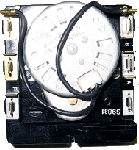
The dryer’s timer routes electricity to the correct dryer components or system at the proper time. Timers are expensive, rarely fail, and are often misdiagnosed. The timer should be allowing electricity to flow to the dryer’s burner and motor when needed.
Dryer Symptoms: Dryer won’t heat, dryer won’t turn on, or dryer won’t turn off.
Test: Use your dryer’s wiring diagram to check for voltage being supplied to the heating circuit or motor circuit.
Gas Dryer Temperature Switch:
A clothes dryer’s temperature selection switch is a simple switch that will send an electrical current to the thermostat heater through resistors. Resistors are usually located on the wires connecting to the switch, but sometimes within the switch itself depending on your model. In this way, the amount of current reaching the dryer’s thermostat heater is controlled. Some dryer models will use a thermistor and a separate solid-state control board to regulate the dryer’s drum temperature. The dryer’s temperature selection switch rarely fails.
Test: Disconnect all connecting wires and check for continuity across the switch and all wire harness resistors. If you have a solid-state control board, visually inspect it for burn marks. Use your dryer’s wiring diagram for more accurate testing.
Remove all connecting wires and check for resistance across the two terminals of the heater. Some resistance should be detected allowing the heater to perform its work. If an open circuit is detected, the heater needs to be replaced. Also, check each of the heater’s contacts to the outer containment unit of the heating element. There should be no connection. If the heater tests okay, check the connected thermostats for continuity and your home’s power supply for full 240-volt supply.
Gas Dryer Thermistor:
A thermistor is a variable resistor that fluctuates the resistance it offers to a circuit 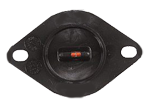 with temperature change. In this way, the thermistor can communicate with a solid-state control board and give very accurate temperature readings. The symptoms of a faulty thermistor could be an error code, incorrect dryer temperatures, or no heat. Thermistors have very specific resistance requirements that are usually listed on a technical sheet located somewhere inside your dryer.
with temperature change. In this way, the thermistor can communicate with a solid-state control board and give very accurate temperature readings. The symptoms of a faulty thermistor could be an error code, incorrect dryer temperatures, or no heat. Thermistors have very specific resistance requirements that are usually listed on a technical sheet located somewhere inside your dryer.
Dryer Symptoms: Dryer won’t heat, or dryer is too hot.
Test: To test a thermistor, disconnect all connecting wires and perform a resistance check. The correct resistance value must be identified for your model and can usually be found on your dryer’s wiring diagram or technical guide, located somewhere inside the dryer.
Gas Dryer Thermostat Heater:
The thermostat heater is often located within the cycling thermostat. However, it may sometimes be a separate component mounted to the dryer’s cycling thermostat. Depending on the dryer’s temperature setting, more or less voltage is supplied to this heater. Low settings provide more voltage and create more heat, while medium settings supply slightly less voltage, generating less heat. High heat settings will not energize the thermostat heater at all. Thus, the thermostat is tricked into thinking that the dryer is hotter than it is, so it opens at a lower temperature. Problems with this system can occur when the temperature selection switch fails to send the proper amount of voltage to the thermostat heater, or the heater itself fails to heat the thermostat.
Dryer Symptoms: Dryer won’t heat, or dryer is too hot.
Test: Remove all connecting wires and check for resistance across the heater contacts. Approximately 3200-4000 ohms of resistance should be measured.
There are two main types of moisture detection used in clothes dryers, electronic and automatic. The electronic dryer moisture sensing system is the most accurate and uses two metal strips somewhere in the dryer drum. When the dryness detection strips are bridged by wet clothing a timer within the dryer’s control board is reset to zero. For “more dry” options the timer may be attempting to count to 70 while for “less dry” it may only be set to reach 30. The automatic style of moisture detection uses the cycling thermostat to power the timer’s motor. In this way, the timer motor only advances as the dryer is cycling the heat source. when the clothes in the dryer are wet this happens much more slowly and speeds up as the cloth dries. in this way the dryer can approximately detect when the clothes are dry.
Dryer Symptoms: The dryer will heat but will turn off in a short time on dryer auto cycles like “more dry”, “less dry”, or “recommended”
Air Flow:
 A dryer’s airflow system is as important as the heat that the dryer generates. A dryer can be as hot as Hades, but if the moisture-saturated air is not removed from the area your clothing will not dry. Clogged internal and home ducting is the number one cause of long dry times and poor drying performance. Disconnecting the dryer’s duct and running a test load will often solve long dry times. If the dryer now magically works, check the ducting for blockages. Dryer manufacturers often suggest limiting duct length to no more than ten feet, each 90º angle in the homes ducting is like adding 5 feet to its length. Vertical home ducting can also be a common source of clogged ducting and heating issues. Click Here for a great dryer duct cleaning tool!
A dryer’s airflow system is as important as the heat that the dryer generates. A dryer can be as hot as Hades, but if the moisture-saturated air is not removed from the area your clothing will not dry. Clogged internal and home ducting is the number one cause of long dry times and poor drying performance. Disconnecting the dryer’s duct and running a test load will often solve long dry times. If the dryer now magically works, check the ducting for blockages. Dryer manufacturers often suggest limiting duct length to no more than ten feet, each 90º angle in the homes ducting is like adding 5 feet to its length. Vertical home ducting can also be a common source of clogged ducting and heating issues. Click Here for a great dryer duct cleaning tool!
Dryer Symptoms: Dryer takes a long time to dry, dryer won’t heat, or dryer gets too hot.
Gas Supply:
Obviously, a gas dryer needs gas to create heat. The burner valve can only release gas if it is being supplied to the dryer. Sometimes gas connections to the dryer can become clogged with too much pipe compound or poor installation. Also, some connections can close internally, blocking gas flow. Always use caution when you are working with gas, and be sure to check for leaks after all connections have been tightened.
Dryer Symptoms: Dryer won’t heat.
Test: Using liquid dish soap is a good way to leak check. Any gas seeping from a connection will create bubbles.


